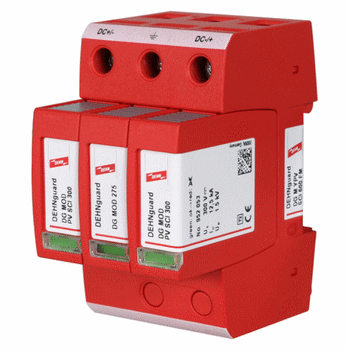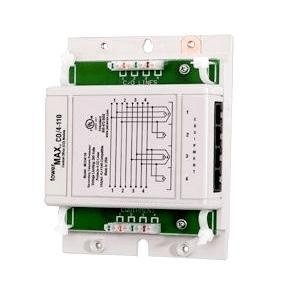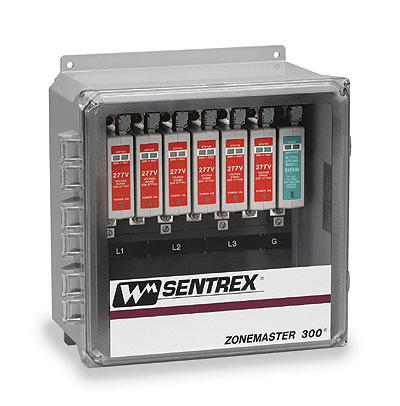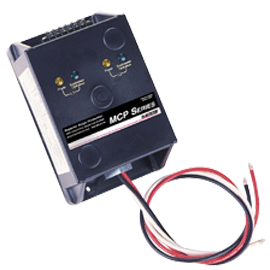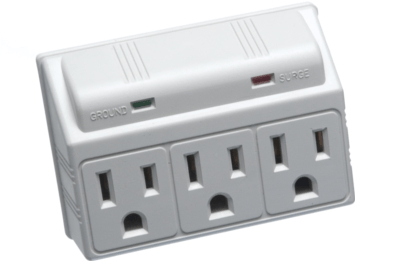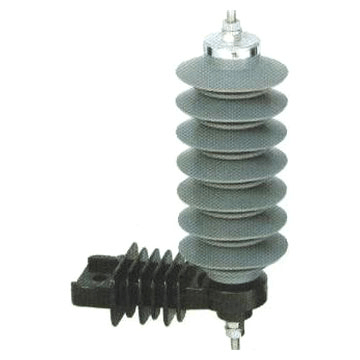Surge Suppressors Information
Surge suppressors, also known as surge protectors or surge protection devices (SPD), serve as interfaces between a power source and a powered device. They allow passage of electrical current when the voltage is within an allowable range; if the voltage spikes above the prescribed level, the suppressor routes the extra voltage to ground, preventing damage to the connected device.
power source and a powered device. They allow passage of electrical current when the voltage is within an allowable range; if the voltage spikes above the prescribed level, the suppressor routes the extra voltage to ground, preventing damage to the connected device.
The simple diagram below describes a surge suppressor's basic operation. This particular suppressor uses metal oxide varistor (MOV) technology which is described in detail below. When normal electrical current flows through the circuit, choke coils or capacitors connected to the gray hot wire move current through the device. In the case of a voltage spike or surge, one of various technologies (in this case the red MOVs) safely conducts the extra voltage into the green ground wire, preventing it from entering and possibly damaging the power outlet and attached connector.
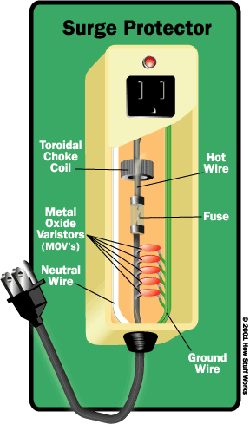
Image credit: HowStuffWorks
Voltage Transients
Transients are defined as any short-lived bursts of electrical energy in an electrical circuit. Surge protection devices are generally able to handle both voltage spikes and surges.
Spikes typically last less than one millisecond (ms). For comparison, a single cycle of 60 Hz alternating current (AC) power takes about 16 milliseconds to complete.
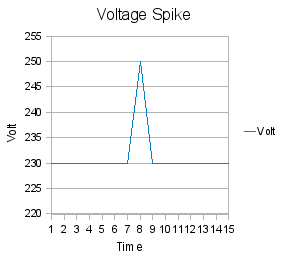
Image credit: Frap
Spikes may be caused by:
-
Lightning
-
Power outage
-
Tripped circuit breakers
-
Short circuits
-
Electromagnetic pulses (EMP)
-
Switch malfunctions or contact "bounce"
Surges are voltage increases that last more than a few seconds, and are typically caused by electric power distribution system malfunctions.
Despite the fact that these two phenomena are referred to as voltage spikes and surges, they are properly energy spikes which are measured in joules (a unit involving voltage, current, and time) rather than voltage.
Selection tip: Surge suppressors rated to 200-1050 J meet the needs of most consumer applications. Products rated to 2000+ J are best suited for large appliances or light industrial use.
Technology
Surge suppressors may incorporate one of several different technology types to operate effectively. The table below summarizes basic information about each technology type.
|
Type |
Advantages |
Disadvantages |
Application |
|
MOV |
Low cost, reliable |
Can only withstand short pulses |
General purpose |
|
Avalanche diode |
High breakdown voltage |
Easily destroyed by typical power system surges |
Static protector, data systems |
|
Thyristor diode |
Handles repeated high voltage surges |
|
Telecom |
|
Gas tube |
Very high voltage |
Slow response time |
High voltage systems |
Metal Oxide Varistor
Metal oxide varistors (MOV) are variable resistance devices situated between a surge suppressor's ground wire and hot wire. When normal voltage is applied, MOVs exhibit very high resistance, allowing the current to continue through the hot wire. When a voltage spike occurs, the MOV's resistance drops, allowing the extra current to flow through the varistors and safely into the ground wire. Metal oxide varistors are able to conduct both polarities of a typical AC power cycle.
This video explains the basic principles behind an MOV surge suppressor.
Video credit: EdisonTechCenter / CC BY-SA 4.0
Silicon Avalanche Diode
Avalanche diodes are similar to MOVs in that they are designed to conduct current at high voltages and resist it at normal voltage. When an avalanche diode reaches its predetermined breakdown voltage, it goes through avalanche breakdown. This process involves a single free electron moving rapidly and knocking other electrons free, allowing the diode to conduct an abnormally large amount of current.
The graph below shows a voltage/current relationship common to Zener and avalanche diodes. Note that, at breakdown voltage VZ, the diode begins to conduct exponentially more current as the voltage continues to increase.
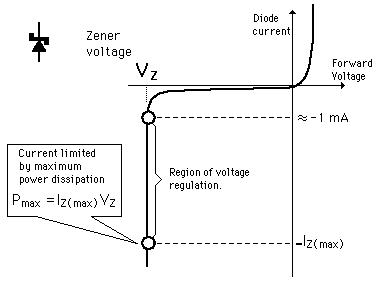
Image credit: R. Victor Jones / Harvard University
Silicon Thyristor Diode
Thyristor diodes are semiconductor devices used to switch large amounts of voltage or power. Their ability to safely conduct repetitive high voltages has resulted in heavy use in the telecommunications industry.
Gas Tubes
Gas tubes, also known as discharge tubes, consist of two separated electrodes immersed in helium, argon, neon, krypton, or other noble gases. When a high voltage is applied to the tube, the current simply arcs between the electrodes and through the gas, effectively clamping the voltage. Gas tubes can handle much higher surges and spikes compared to MOVs and diodes, but are also much slower.
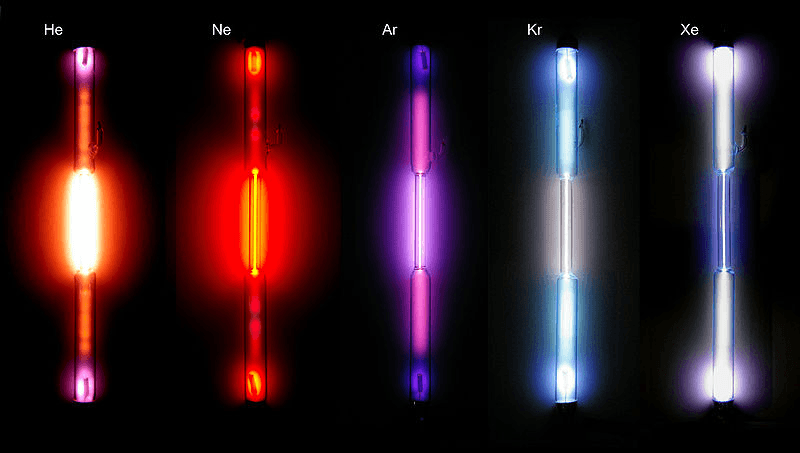
Gas tubes (left to right): helium, neon, argon, krypton, xenon.
Image credit: Wikipedia
Device Type
Surge suppressors are manufactured using a variety of different form factors and configurations. Common examples include:
|
Type |
Description |
Image |
|
Formerly transient voltage surge suppressors (TVSS). SPDs are standard devices that protect against routine overvoltage. |
|
|
|
Protect against transient voltage on DC and data circuits. Used with computers and telecom equipment. |
|
|
|
Non-plugin style devices used with single-phase AC power. |
|
|
|
Non-plugin style products used with three-phase AC power. |
|
|
|
Plugged into wall outlets to protect against voltage transients. |
|
|
|
Lightning arrestors |
Specialized suppressors that protect against surges due to lightning. |
|
Image credits: IndustrySearch | PCRush | Cole Parmer | Smiths Power | Show Me Cables | Fuerte
Standards and Approvals
UL
Underwriters Laboratory (UL) is a global certification, testing, and standards organization. UL-published standards related to surge suppressors include:
-
UL 1449 - These requirements cover Surge Protective Devices (SPDs) designed for repeated limiting of transient voltage surges as specified in the standard on 50 or 60 Hz power circuits not exceeding 1000 V
-
UL 497A - These requirements cover secondary protectors for use in single- or multiple-pair-type communications circuits that are intended to be installed in accordance with Article 800 of the National Electrical Code, ANSI/NFPA 70.
-
UL 497B - These requirements cover protectors for data communications and fire-alarm circuits.
ANSI
The American National Standards Institute (ANSI) is a private non-profit standards developer based in the United States. ANSI also interfaces with international standards bodies to ensure that U.S.-made products can safely be used in other parts of the world. ANSI developed the important National Electrical Code (NFPA 70), which is especially important for electrical safety products.
RoHS
The Restriction of Hazardous Substances directive (RoHS) is a European Union order which restricts the use of six hazardous materials in the manufacture of electrical devices. Although they are often simply referred to as "lead-free", RoHS products also contain less than 0.1% of:
-
Mercury
-
Cadmium
-
Hexavalent chromium (Cr6+)
-
Polybrominated biphenyls (PBB)
-
Polybrominated diphenyl ether (PBDE)
The RoHS directive protects the health of electronics industry workers and those in close proximity to areas where high-tech waste is stored. While RoHS compliant products do not carry a standard mark or seal, the image below presents a typical example.
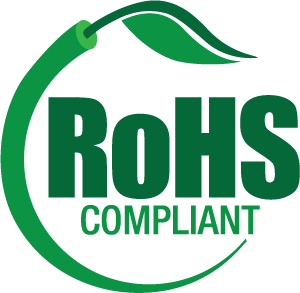
Image credit: Advanced Digital Cable Inc.
WEEE
The Waste Electrical and Electronic Equipment directive (WEEE) became European Law in 2003, at the same time as the RoHS directive. WEEE legislation sets collection, recycling, and recovery targets of electrical products, with minimum amounts for recycling recovery. WEEE compliant manufacturers and distributors must provide users with the possibility of recycling household electronic equipment free of charge.

The WEEE symbol. Image credit: European Union
CE
A Conformité Européenne (CE) mark ensures that a product complies with European Union (EU) legislation and may be placed on the European market. A CE mark is not legally required to certify a product's quality, but it often ensures quality in specialty applications such as medical use.
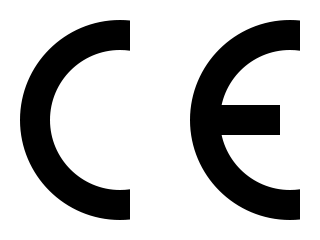
A CE mark. Image credit: Wikimedia
CSA
The Canadian Standards Association (CSA) is a comparable standards organization for products manufactured in Canada.
The registered mark of the UL or CSA indicates that a product has been tested and certified to meet the organization's recognized standards.
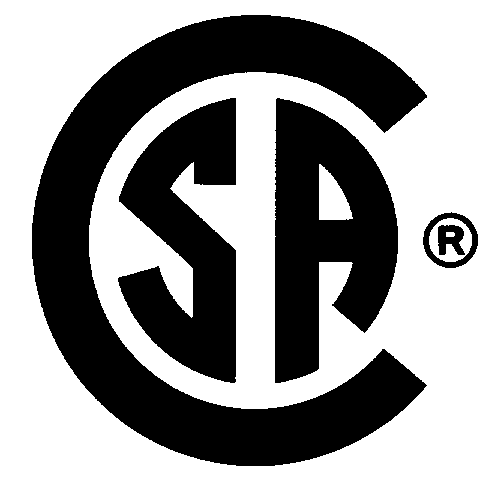
CSA mark. Image credit: ul.com
References
Francois Martzloff - Surge Protection Techniques in Low-Voltage AC Power Systems (pdf)
- Alabama
- Arizona
- California
- Colorado
- Connecticut
- Florida
- Georgia
- Idaho
- Illinois
- Indiana
- Kansas
- Louisiana
- Massachusetts
- Maryland
- Michigan
- Minnesota
- Missouri
- Mississippi
- North Carolina
- New Hampshire
- New Jersey
- Nevada
- New York
- Ohio
- Oklahoma
- Oregon
- Pennsylvania
- Rhode Island
- South Carolina
- Tennessee
- Texas
- Utah
- Virginia
- Washington
- Wisconsin
- ANSI
- Audio and Video Applications
- CE Marking
- CSA Mark
- Coaxial / RF Surge Suppressors
- Computer Rooms
- DIN Rail
- Data Acquisition
- Dataline and DC Signal
- Gas Tube
- Hard-Wired / Device Mount
- Hybrid
- IEC
- IEEE
- In-Line / Integrally Attached
- Lightning Arrestor
- MOV
- Medical Facilities
- Network Applications
- PCB Mount
- Plug-in Module
- Plug-in Style
- Rack Mount Type
- RoHS Compliant
- SPD
- Silicon Avalanche Diode
- Silicon Thyristor Diode
- Single Phase
- Telecom Applications
- Three Phase
- UL
- UL 1449 Second Edition
- UL 1449 Fourth Edition
- UL 1449 Third Edition
- UL 497A Rating
- UL 497B Rating
- Wall / Panel / Backboard Mount
- voltage surge protector
- lightning surge protector
- RF surge protector
- gas tube surge arrester
- industrial surge protectors
- cat5 surge protectors
- surge suppressor for generators
- 110 220 volt surge protectors
- 120 volt inline surge protectors
- 120 volt surge suppressors
- 15 amp surge protectors
- 20 amp surge protectors
- 208 3 phase surge protectors
- 220 volt surge suppressors
- 220V industrial surge protectors
- 220V surge suppressors
- 24 volt AC surge protectors
- 3 phase surge protectors
- 480 volt industrial surge protectors
- 480 volt surge suppressors
- 480v 3 phase surge protectors
- 7 outlet surge protectors
- analog signal surge suppressors
- automotive 12 volt surge protectors
- brick wall surge protectors
- cat6 PoE surge protectors
- coaxial cable surge suppressors
- DC surge arresters
- emp proof surge protectors
- fuse box surge protectors
